Business Strategy Report: Analyzing John Lewis Ltd (HNBS 332)
VerifiedAdded on 2021/01/02
|14
|3751
|366
Report
AI Summary
This report provides a comprehensive analysis of John Lewis Ltd's business strategy, examining its macro and internal environments. The analysis begins with an application of the PESTLE framework to assess the impact of political, economic, social, technological, legal, and environmental factors. It then delves into the internal environment using SWOT and VRIO models to evaluate the company's strengths, weaknesses, opportunities, threats, and its resources and capabilities. Furthermore, the report applies Porter's Five Forces model to assess the competitive dynamics within the retail sector. Finally, the report incorporates the Ansoff matrix to evaluate strategic growth options. The report concludes with a synthesis of the findings and recommendations for the company's future strategic direction. The report is a detailed analysis of John Lewis's strategic position within the retail market and the factors influencing its performance.
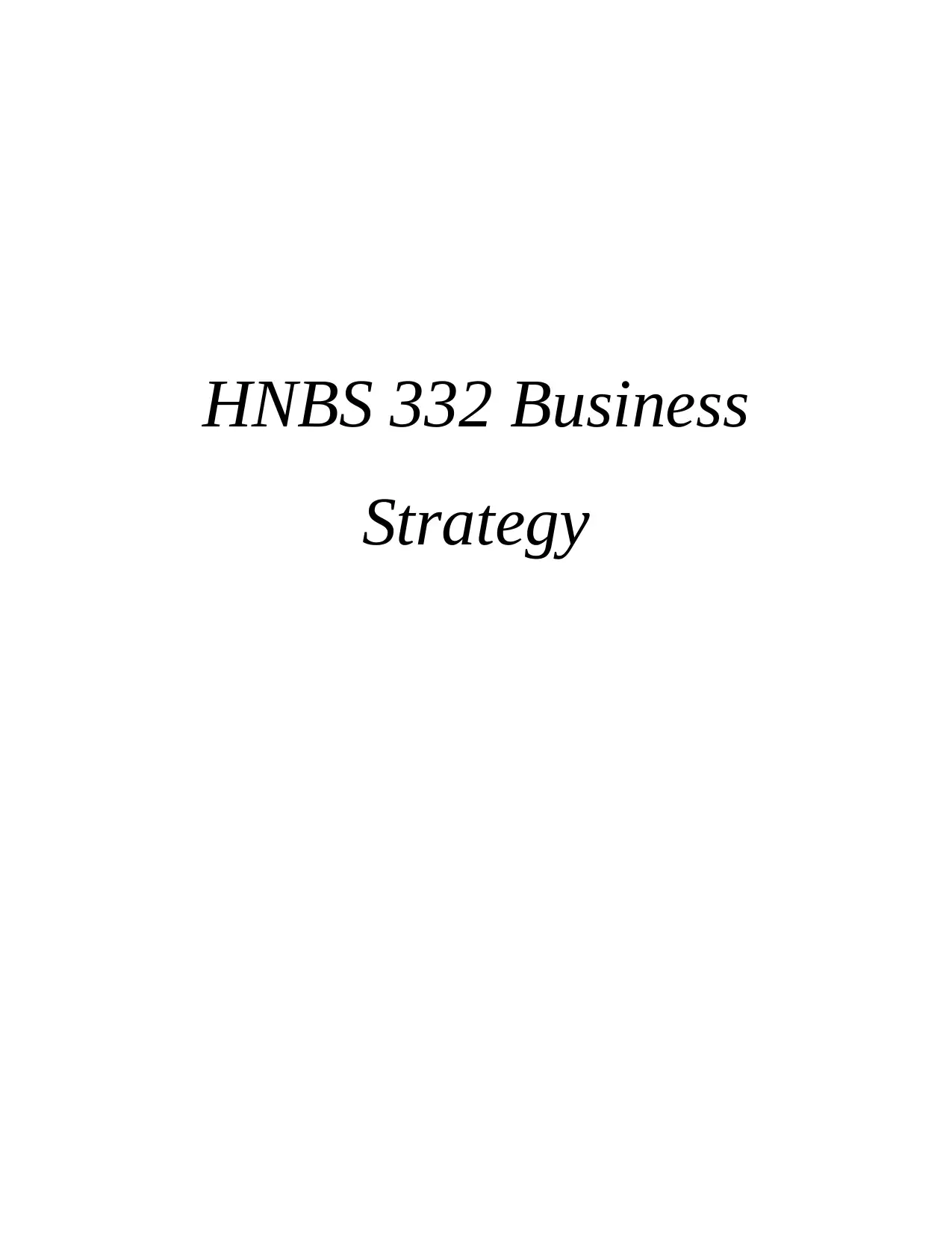
HNBS 332 Business
Strategy
Strategy
Paraphrase This Document
Need a fresh take? Get an instant paraphrase of this document with our AI Paraphraser
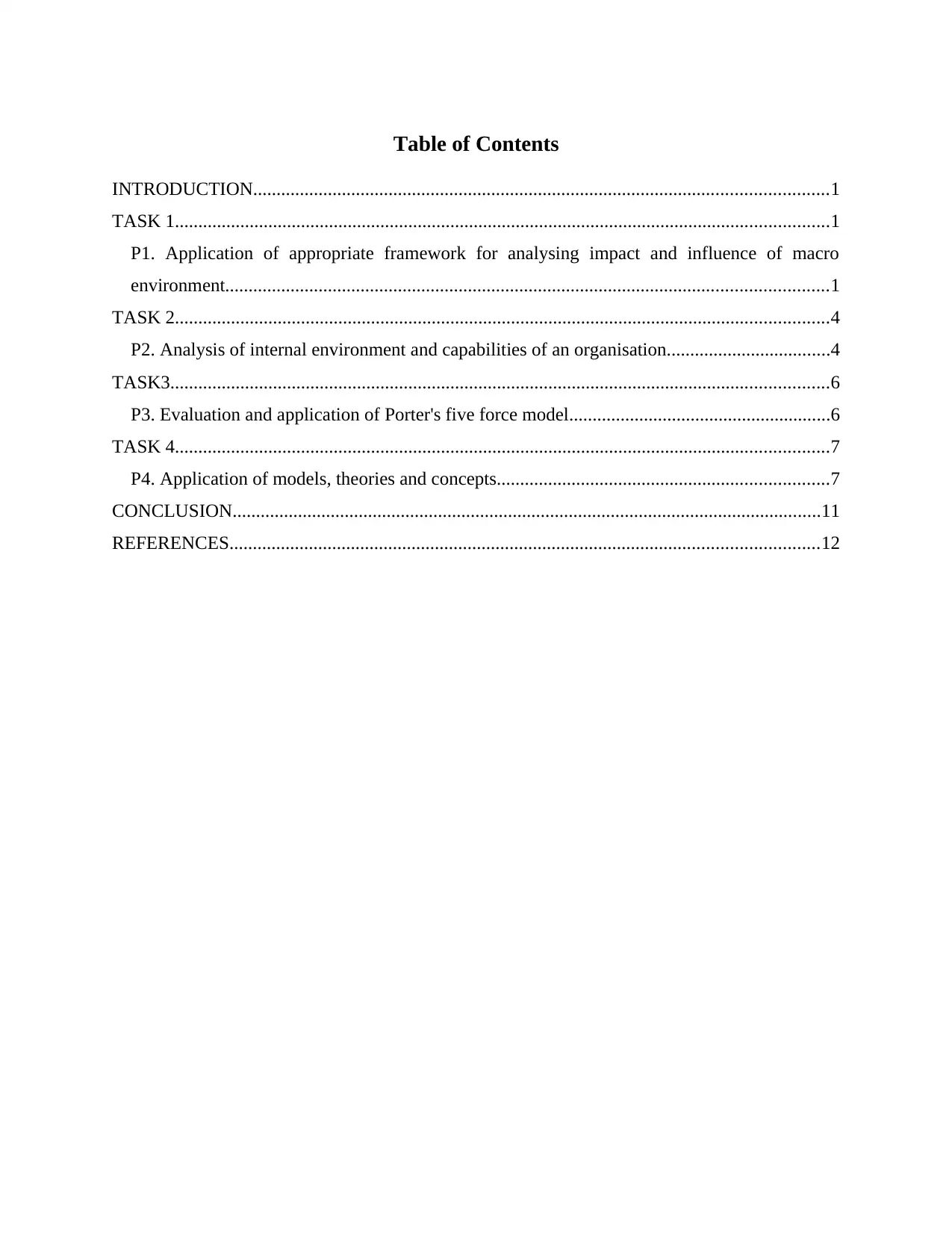
Table of Contents
INTRODUCTION...........................................................................................................................1
TASK 1............................................................................................................................................1
P1. Application of appropriate framework for analysing impact and influence of macro
environment.................................................................................................................................1
TASK 2............................................................................................................................................4
P2. Analysis of internal environment and capabilities of an organisation...................................4
TASK3.............................................................................................................................................6
P3. Evaluation and application of Porter's five force model........................................................6
TASK 4............................................................................................................................................7
P4. Application of models, theories and concepts.......................................................................7
CONCLUSION..............................................................................................................................11
REFERENCES..............................................................................................................................12
INTRODUCTION...........................................................................................................................1
TASK 1............................................................................................................................................1
P1. Application of appropriate framework for analysing impact and influence of macro
environment.................................................................................................................................1
TASK 2............................................................................................................................................4
P2. Analysis of internal environment and capabilities of an organisation...................................4
TASK3.............................................................................................................................................6
P3. Evaluation and application of Porter's five force model........................................................6
TASK 4............................................................................................................................................7
P4. Application of models, theories and concepts.......................................................................7
CONCLUSION..............................................................................................................................11
REFERENCES..............................................................................................................................12
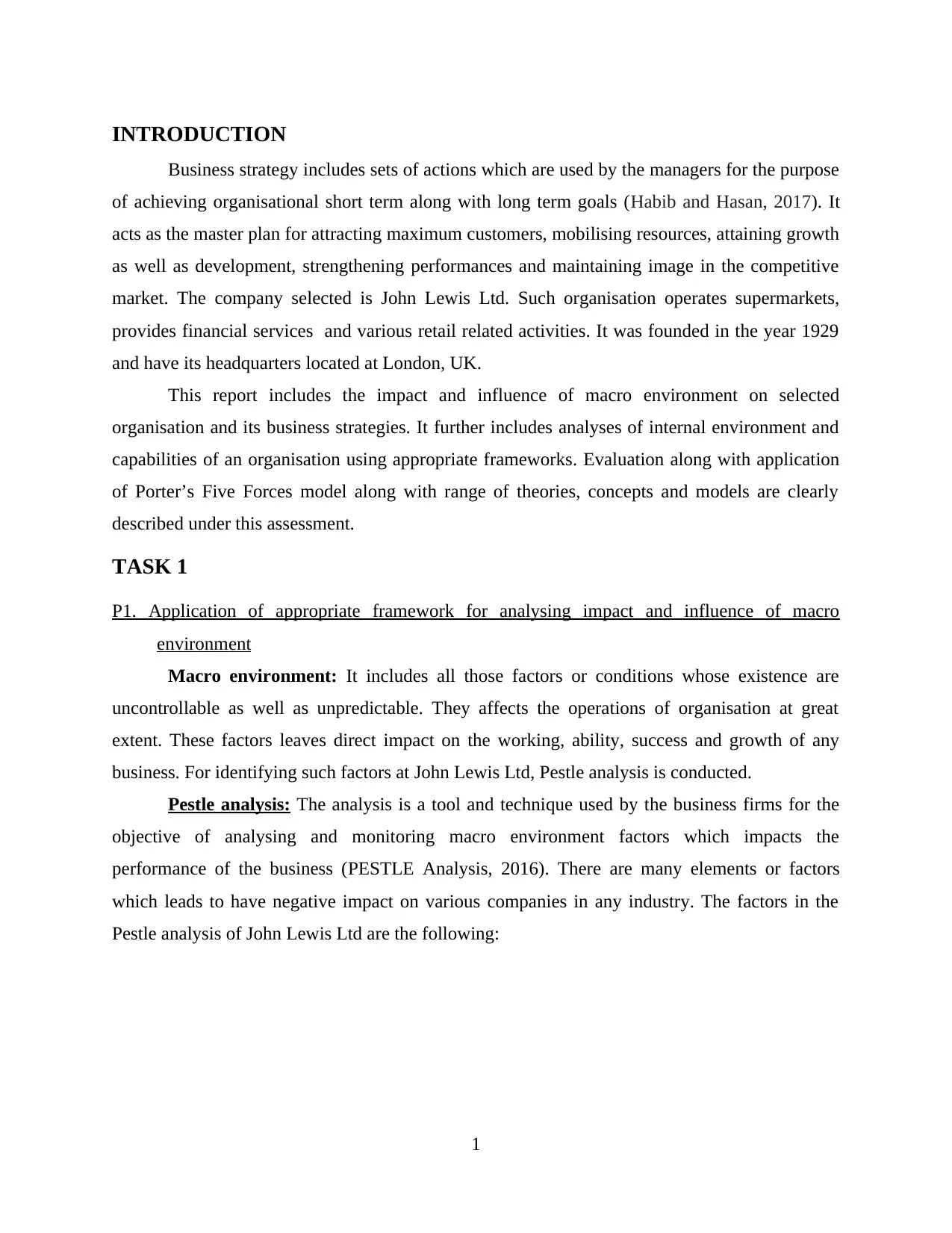
INTRODUCTION
Business strategy includes sets of actions which are used by the managers for the purpose
of achieving organisational short term along with long term goals (Habib and Hasan, 2017). It
acts as the master plan for attracting maximum customers, mobilising resources, attaining growth
as well as development, strengthening performances and maintaining image in the competitive
market. The company selected is John Lewis Ltd. Such organisation operates supermarkets,
provides financial services and various retail related activities. It was founded in the year 1929
and have its headquarters located at London, UK.
This report includes the impact and influence of macro environment on selected
organisation and its business strategies. It further includes analyses of internal environment and
capabilities of an organisation using appropriate frameworks. Evaluation along with application
of Porter’s Five Forces model along with range of theories, concepts and models are clearly
described under this assessment.
TASK 1
P1. Application of appropriate framework for analysing impact and influence of macro
environment
Macro environment: It includes all those factors or conditions whose existence are
uncontrollable as well as unpredictable. They affects the operations of organisation at great
extent. These factors leaves direct impact on the working, ability, success and growth of any
business. For identifying such factors at John Lewis Ltd, Pestle analysis is conducted.
Pestle analysis: The analysis is a tool and technique used by the business firms for the
objective of analysing and monitoring macro environment factors which impacts the
performance of the business (PESTLE Analysis, 2016). There are many elements or factors
which leads to have negative impact on various companies in any industry. The factors in the
Pestle analysis of John Lewis Ltd are the following:
1
Business strategy includes sets of actions which are used by the managers for the purpose
of achieving organisational short term along with long term goals (Habib and Hasan, 2017). It
acts as the master plan for attracting maximum customers, mobilising resources, attaining growth
as well as development, strengthening performances and maintaining image in the competitive
market. The company selected is John Lewis Ltd. Such organisation operates supermarkets,
provides financial services and various retail related activities. It was founded in the year 1929
and have its headquarters located at London, UK.
This report includes the impact and influence of macro environment on selected
organisation and its business strategies. It further includes analyses of internal environment and
capabilities of an organisation using appropriate frameworks. Evaluation along with application
of Porter’s Five Forces model along with range of theories, concepts and models are clearly
described under this assessment.
TASK 1
P1. Application of appropriate framework for analysing impact and influence of macro
environment
Macro environment: It includes all those factors or conditions whose existence are
uncontrollable as well as unpredictable. They affects the operations of organisation at great
extent. These factors leaves direct impact on the working, ability, success and growth of any
business. For identifying such factors at John Lewis Ltd, Pestle analysis is conducted.
Pestle analysis: The analysis is a tool and technique used by the business firms for the
objective of analysing and monitoring macro environment factors which impacts the
performance of the business (PESTLE Analysis, 2016). There are many elements or factors
which leads to have negative impact on various companies in any industry. The factors in the
Pestle analysis of John Lewis Ltd are the following:
1
⊘ This is a preview!⊘
Do you want full access?
Subscribe today to unlock all pages.

Trusted by 1+ million students worldwide
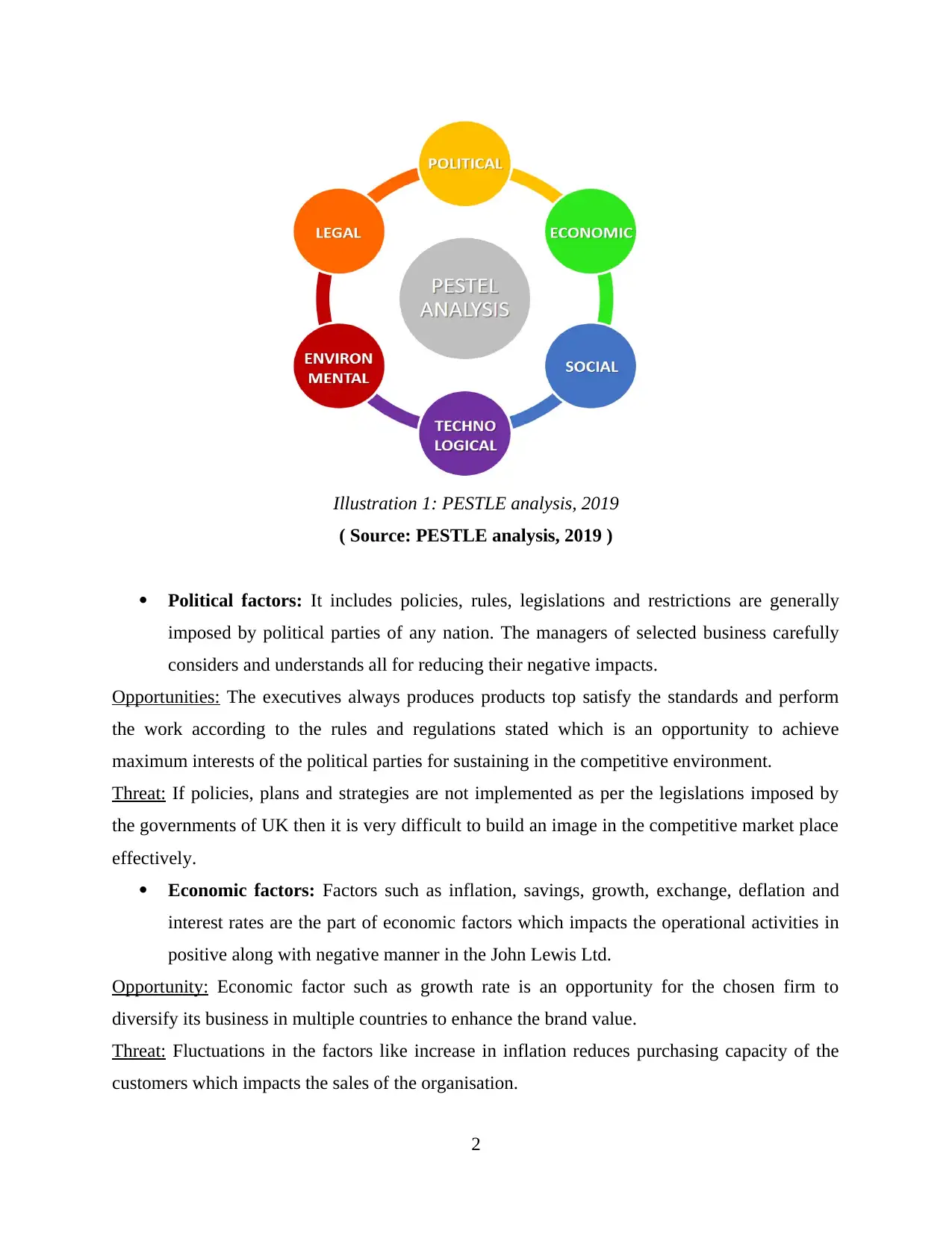
Illustration 1: PESTLE analysis, 2019
( Source: PESTLE analysis, 2019 )
Political factors: It includes policies, rules, legislations and restrictions are generally
imposed by political parties of any nation. The managers of selected business carefully
considers and understands all for reducing their negative impacts.
Opportunities: The executives always produces products top satisfy the standards and perform
the work according to the rules and regulations stated which is an opportunity to achieve
maximum interests of the political parties for sustaining in the competitive environment.
Threat: If policies, plans and strategies are not implemented as per the legislations imposed by
the governments of UK then it is very difficult to build an image in the competitive market place
effectively.
Economic factors: Factors such as inflation, savings, growth, exchange, deflation and
interest rates are the part of economic factors which impacts the operational activities in
positive along with negative manner in the John Lewis Ltd.
Opportunity: Economic factor such as growth rate is an opportunity for the chosen firm to
diversify its business in multiple countries to enhance the brand value.
Threat: Fluctuations in the factors like increase in inflation reduces purchasing capacity of the
customers which impacts the sales of the organisation.
2
( Source: PESTLE analysis, 2019 )
Political factors: It includes policies, rules, legislations and restrictions are generally
imposed by political parties of any nation. The managers of selected business carefully
considers and understands all for reducing their negative impacts.
Opportunities: The executives always produces products top satisfy the standards and perform
the work according to the rules and regulations stated which is an opportunity to achieve
maximum interests of the political parties for sustaining in the competitive environment.
Threat: If policies, plans and strategies are not implemented as per the legislations imposed by
the governments of UK then it is very difficult to build an image in the competitive market place
effectively.
Economic factors: Factors such as inflation, savings, growth, exchange, deflation and
interest rates are the part of economic factors which impacts the operational activities in
positive along with negative manner in the John Lewis Ltd.
Opportunity: Economic factor such as growth rate is an opportunity for the chosen firm to
diversify its business in multiple countries to enhance the brand value.
Threat: Fluctuations in the factors like increase in inflation reduces purchasing capacity of the
customers which impacts the sales of the organisation.
2
Paraphrase This Document
Need a fresh take? Get an instant paraphrase of this document with our AI Paraphraser
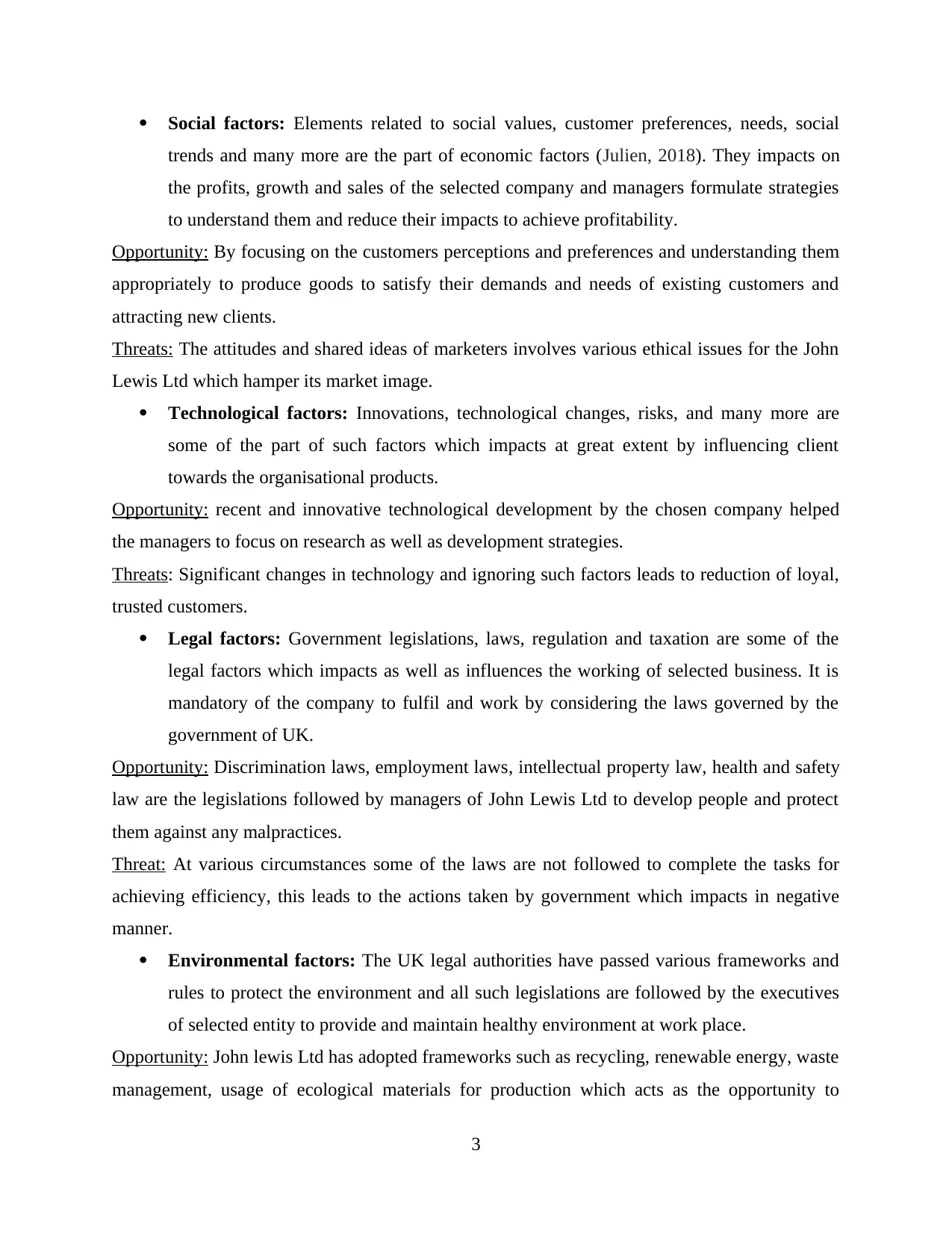
Social factors: Elements related to social values, customer preferences, needs, social
trends and many more are the part of economic factors (Julien, 2018). They impacts on
the profits, growth and sales of the selected company and managers formulate strategies
to understand them and reduce their impacts to achieve profitability.
Opportunity: By focusing on the customers perceptions and preferences and understanding them
appropriately to produce goods to satisfy their demands and needs of existing customers and
attracting new clients.
Threats: The attitudes and shared ideas of marketers involves various ethical issues for the John
Lewis Ltd which hamper its market image.
Technological factors: Innovations, technological changes, risks, and many more are
some of the part of such factors which impacts at great extent by influencing client
towards the organisational products.
Opportunity: recent and innovative technological development by the chosen company helped
the managers to focus on research as well as development strategies.
Threats: Significant changes in technology and ignoring such factors leads to reduction of loyal,
trusted customers.
Legal factors: Government legislations, laws, regulation and taxation are some of the
legal factors which impacts as well as influences the working of selected business. It is
mandatory of the company to fulfil and work by considering the laws governed by the
government of UK.
Opportunity: Discrimination laws, employment laws, intellectual property law, health and safety
law are the legislations followed by managers of John Lewis Ltd to develop people and protect
them against any malpractices.
Threat: At various circumstances some of the laws are not followed to complete the tasks for
achieving efficiency, this leads to the actions taken by government which impacts in negative
manner.
Environmental factors: The UK legal authorities have passed various frameworks and
rules to protect the environment and all such legislations are followed by the executives
of selected entity to provide and maintain healthy environment at work place.
Opportunity: John lewis Ltd has adopted frameworks such as recycling, renewable energy, waste
management, usage of ecological materials for production which acts as the opportunity to
3
trends and many more are the part of economic factors (Julien, 2018). They impacts on
the profits, growth and sales of the selected company and managers formulate strategies
to understand them and reduce their impacts to achieve profitability.
Opportunity: By focusing on the customers perceptions and preferences and understanding them
appropriately to produce goods to satisfy their demands and needs of existing customers and
attracting new clients.
Threats: The attitudes and shared ideas of marketers involves various ethical issues for the John
Lewis Ltd which hamper its market image.
Technological factors: Innovations, technological changes, risks, and many more are
some of the part of such factors which impacts at great extent by influencing client
towards the organisational products.
Opportunity: recent and innovative technological development by the chosen company helped
the managers to focus on research as well as development strategies.
Threats: Significant changes in technology and ignoring such factors leads to reduction of loyal,
trusted customers.
Legal factors: Government legislations, laws, regulation and taxation are some of the
legal factors which impacts as well as influences the working of selected business. It is
mandatory of the company to fulfil and work by considering the laws governed by the
government of UK.
Opportunity: Discrimination laws, employment laws, intellectual property law, health and safety
law are the legislations followed by managers of John Lewis Ltd to develop people and protect
them against any malpractices.
Threat: At various circumstances some of the laws are not followed to complete the tasks for
achieving efficiency, this leads to the actions taken by government which impacts in negative
manner.
Environmental factors: The UK legal authorities have passed various frameworks and
rules to protect the environment and all such legislations are followed by the executives
of selected entity to provide and maintain healthy environment at work place.
Opportunity: John lewis Ltd has adopted frameworks such as recycling, renewable energy, waste
management, usage of ecological materials for production which acts as the opportunity to
3
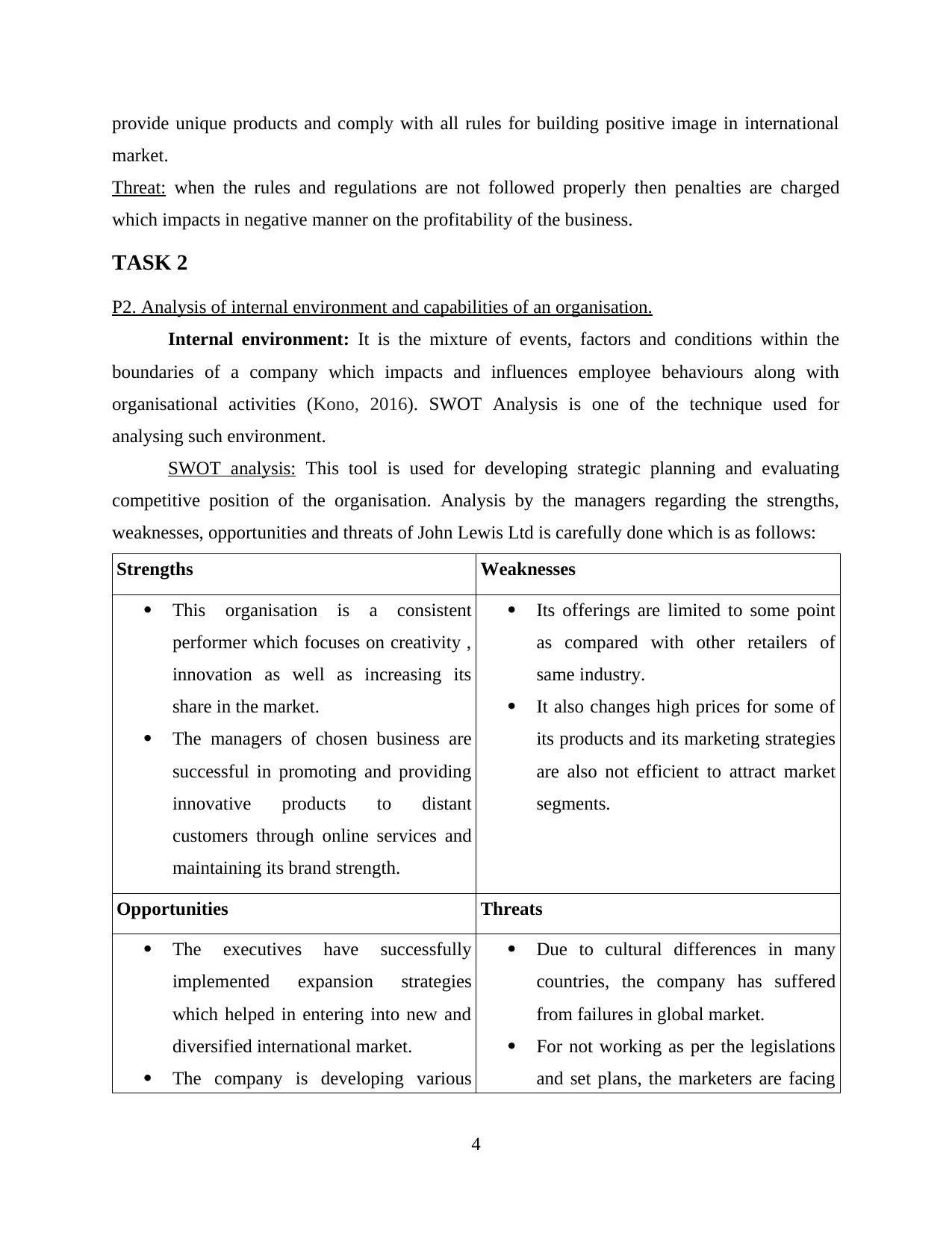
provide unique products and comply with all rules for building positive image in international
market.
Threat: when the rules and regulations are not followed properly then penalties are charged
which impacts in negative manner on the profitability of the business.
TASK 2
P2. Analysis of internal environment and capabilities of an organisation.
Internal environment: It is the mixture of events, factors and conditions within the
boundaries of a company which impacts and influences employee behaviours along with
organisational activities (Kono, 2016). SWOT Analysis is one of the technique used for
analysing such environment.
SWOT analysis: This tool is used for developing strategic planning and evaluating
competitive position of the organisation. Analysis by the managers regarding the strengths,
weaknesses, opportunities and threats of John Lewis Ltd is carefully done which is as follows:
Strengths Weaknesses
This organisation is a consistent
performer which focuses on creativity ,
innovation as well as increasing its
share in the market.
The managers of chosen business are
successful in promoting and providing
innovative products to distant
customers through online services and
maintaining its brand strength.
Its offerings are limited to some point
as compared with other retailers of
same industry.
It also changes high prices for some of
its products and its marketing strategies
are also not efficient to attract market
segments.
Opportunities Threats
The executives have successfully
implemented expansion strategies
which helped in entering into new and
diversified international market.
The company is developing various
Due to cultural differences in many
countries, the company has suffered
from failures in global market.
For not working as per the legislations
and set plans, the marketers are facing
4
market.
Threat: when the rules and regulations are not followed properly then penalties are charged
which impacts in negative manner on the profitability of the business.
TASK 2
P2. Analysis of internal environment and capabilities of an organisation.
Internal environment: It is the mixture of events, factors and conditions within the
boundaries of a company which impacts and influences employee behaviours along with
organisational activities (Kono, 2016). SWOT Analysis is one of the technique used for
analysing such environment.
SWOT analysis: This tool is used for developing strategic planning and evaluating
competitive position of the organisation. Analysis by the managers regarding the strengths,
weaknesses, opportunities and threats of John Lewis Ltd is carefully done which is as follows:
Strengths Weaknesses
This organisation is a consistent
performer which focuses on creativity ,
innovation as well as increasing its
share in the market.
The managers of chosen business are
successful in promoting and providing
innovative products to distant
customers through online services and
maintaining its brand strength.
Its offerings are limited to some point
as compared with other retailers of
same industry.
It also changes high prices for some of
its products and its marketing strategies
are also not efficient to attract market
segments.
Opportunities Threats
The executives have successfully
implemented expansion strategies
which helped in entering into new and
diversified international market.
The company is developing various
Due to cultural differences in many
countries, the company has suffered
from failures in global market.
For not working as per the legislations
and set plans, the marketers are facing
4
⊘ This is a preview!⊘
Do you want full access?
Subscribe today to unlock all pages.

Trusted by 1+ million students worldwide
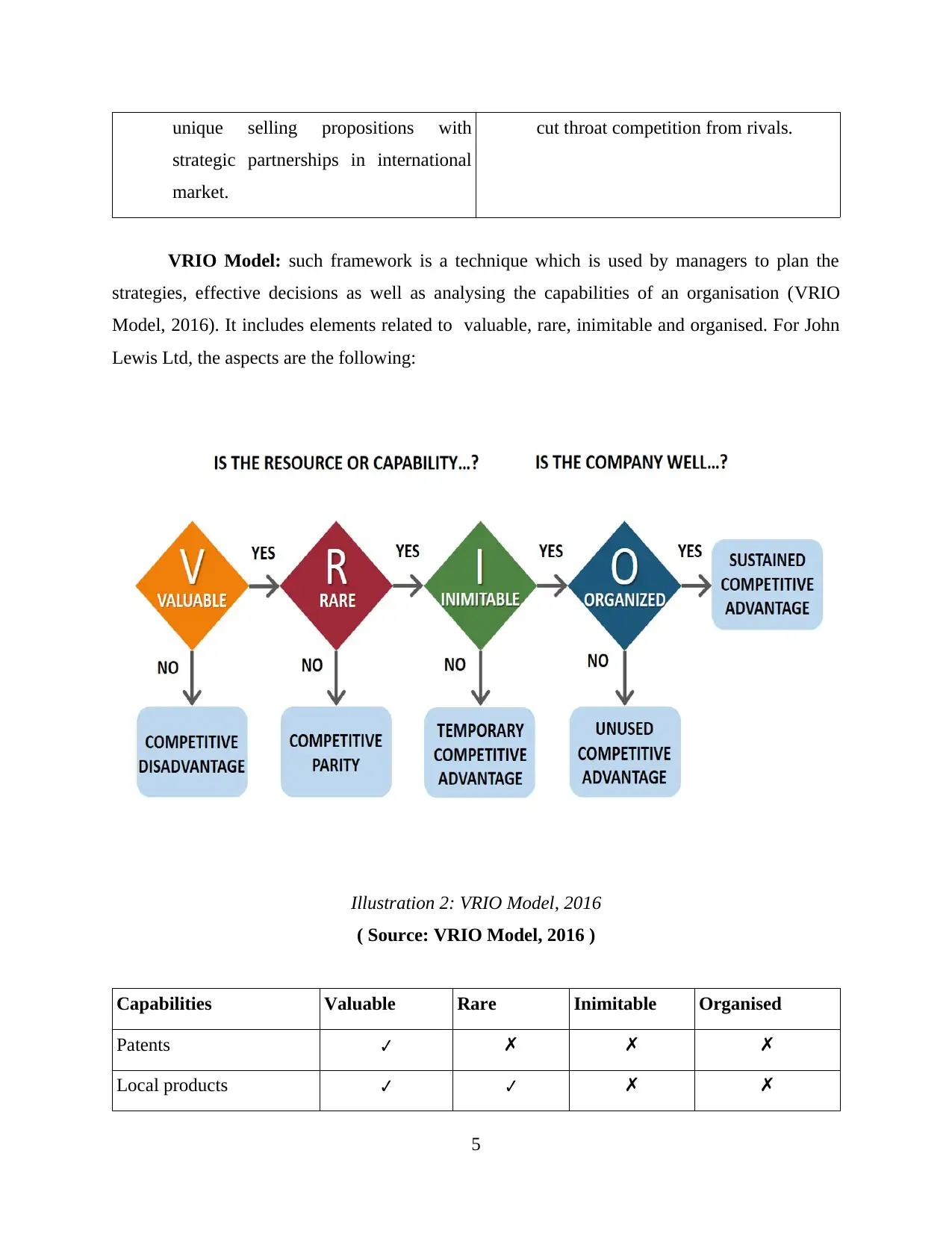
unique selling propositions with
strategic partnerships in international
market.
cut throat competition from rivals.
VRIO Model: such framework is a technique which is used by managers to plan the
strategies, effective decisions as well as analysing the capabilities of an organisation (VRIO
Model, 2016). It includes elements related to valuable, rare, inimitable and organised. For John
Lewis Ltd, the aspects are the following:
Illustration 2: VRIO Model, 2016
( Source: VRIO Model, 2016 )
Capabilities Valuable Rare Inimitable Organised
Patents ✔ ✗ ✗ ✗
Local products ✔ ✔ ✗ ✗
5
strategic partnerships in international
market.
cut throat competition from rivals.
VRIO Model: such framework is a technique which is used by managers to plan the
strategies, effective decisions as well as analysing the capabilities of an organisation (VRIO
Model, 2016). It includes elements related to valuable, rare, inimitable and organised. For John
Lewis Ltd, the aspects are the following:
Illustration 2: VRIO Model, 2016
( Source: VRIO Model, 2016 )
Capabilities Valuable Rare Inimitable Organised
Patents ✔ ✗ ✗ ✗
Local products ✔ ✔ ✗ ✗
5
Paraphrase This Document
Need a fresh take? Get an instant paraphrase of this document with our AI Paraphraser
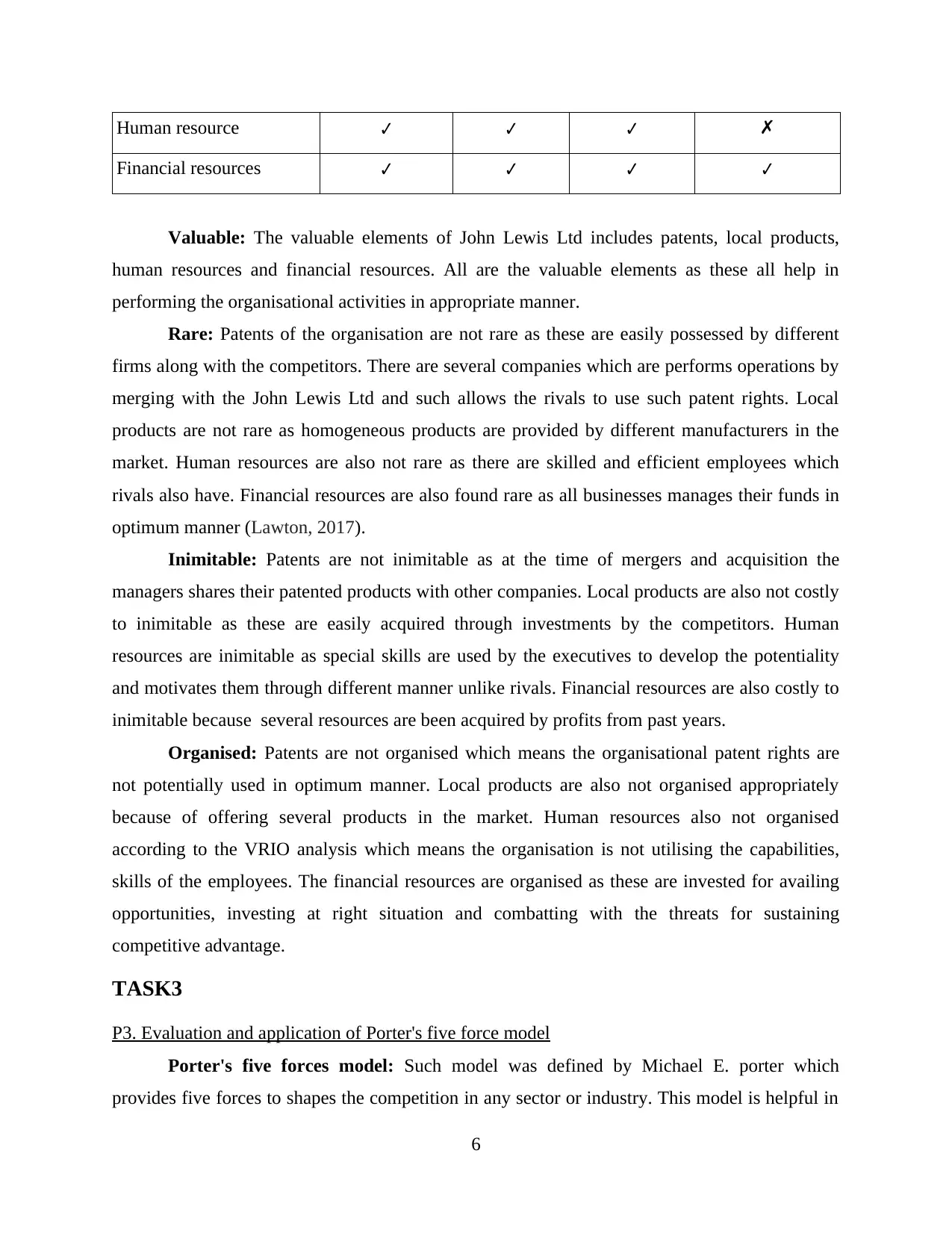
Human resource ✔ ✔ ✔ ✗
Financial resources ✔ ✔ ✔ ✔
Valuable: The valuable elements of John Lewis Ltd includes patents, local products,
human resources and financial resources. All are the valuable elements as these all help in
performing the organisational activities in appropriate manner.
Rare: Patents of the organisation are not rare as these are easily possessed by different
firms along with the competitors. There are several companies which are performs operations by
merging with the John Lewis Ltd and such allows the rivals to use such patent rights. Local
products are not rare as homogeneous products are provided by different manufacturers in the
market. Human resources are also not rare as there are skilled and efficient employees which
rivals also have. Financial resources are also found rare as all businesses manages their funds in
optimum manner (Lawton, 2017).
Inimitable: Patents are not inimitable as at the time of mergers and acquisition the
managers shares their patented products with other companies. Local products are also not costly
to inimitable as these are easily acquired through investments by the competitors. Human
resources are inimitable as special skills are used by the executives to develop the potentiality
and motivates them through different manner unlike rivals. Financial resources are also costly to
inimitable because several resources are been acquired by profits from past years.
Organised: Patents are not organised which means the organisational patent rights are
not potentially used in optimum manner. Local products are also not organised appropriately
because of offering several products in the market. Human resources also not organised
according to the VRIO analysis which means the organisation is not utilising the capabilities,
skills of the employees. The financial resources are organised as these are invested for availing
opportunities, investing at right situation and combatting with the threats for sustaining
competitive advantage.
TASK3
P3. Evaluation and application of Porter's five force model
Porter's five forces model: Such model was defined by Michael E. porter which
provides five forces to shapes the competition in any sector or industry. This model is helpful in
6
Financial resources ✔ ✔ ✔ ✔
Valuable: The valuable elements of John Lewis Ltd includes patents, local products,
human resources and financial resources. All are the valuable elements as these all help in
performing the organisational activities in appropriate manner.
Rare: Patents of the organisation are not rare as these are easily possessed by different
firms along with the competitors. There are several companies which are performs operations by
merging with the John Lewis Ltd and such allows the rivals to use such patent rights. Local
products are not rare as homogeneous products are provided by different manufacturers in the
market. Human resources are also not rare as there are skilled and efficient employees which
rivals also have. Financial resources are also found rare as all businesses manages their funds in
optimum manner (Lawton, 2017).
Inimitable: Patents are not inimitable as at the time of mergers and acquisition the
managers shares their patented products with other companies. Local products are also not costly
to inimitable as these are easily acquired through investments by the competitors. Human
resources are inimitable as special skills are used by the executives to develop the potentiality
and motivates them through different manner unlike rivals. Financial resources are also costly to
inimitable because several resources are been acquired by profits from past years.
Organised: Patents are not organised which means the organisational patent rights are
not potentially used in optimum manner. Local products are also not organised appropriately
because of offering several products in the market. Human resources also not organised
according to the VRIO analysis which means the organisation is not utilising the capabilities,
skills of the employees. The financial resources are organised as these are invested for availing
opportunities, investing at right situation and combatting with the threats for sustaining
competitive advantage.
TASK3
P3. Evaluation and application of Porter's five force model
Porter's five forces model: Such model was defined by Michael E. porter which
provides five forces to shapes the competition in any sector or industry. This model is helpful in
6
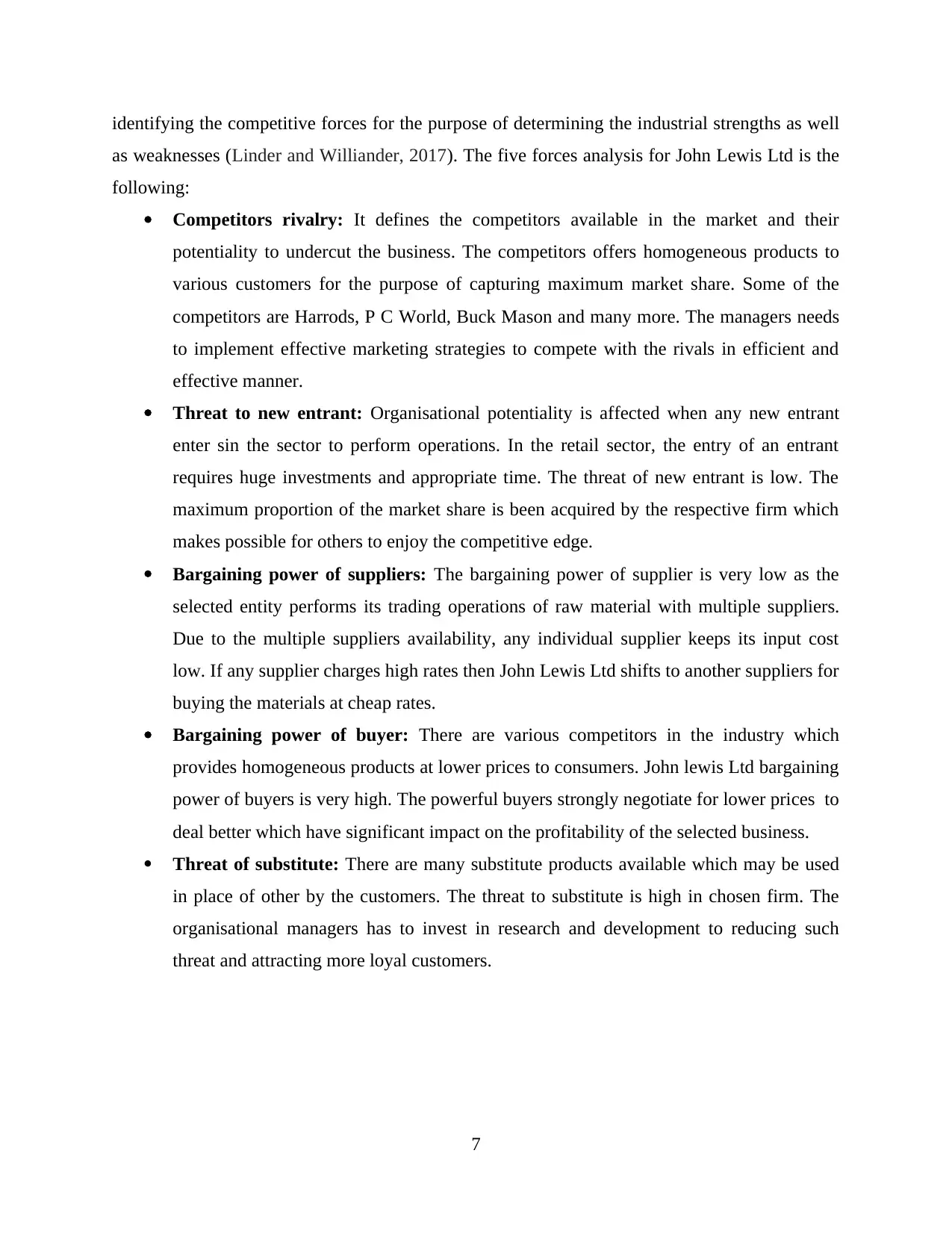
identifying the competitive forces for the purpose of determining the industrial strengths as well
as weaknesses (Linder and Williander, 2017). The five forces analysis for John Lewis Ltd is the
following:
Competitors rivalry: It defines the competitors available in the market and their
potentiality to undercut the business. The competitors offers homogeneous products to
various customers for the purpose of capturing maximum market share. Some of the
competitors are Harrods, P C World, Buck Mason and many more. The managers needs
to implement effective marketing strategies to compete with the rivals in efficient and
effective manner.
Threat to new entrant: Organisational potentiality is affected when any new entrant
enter sin the sector to perform operations. In the retail sector, the entry of an entrant
requires huge investments and appropriate time. The threat of new entrant is low. The
maximum proportion of the market share is been acquired by the respective firm which
makes possible for others to enjoy the competitive edge.
Bargaining power of suppliers: The bargaining power of supplier is very low as the
selected entity performs its trading operations of raw material with multiple suppliers.
Due to the multiple suppliers availability, any individual supplier keeps its input cost
low. If any supplier charges high rates then John Lewis Ltd shifts to another suppliers for
buying the materials at cheap rates.
Bargaining power of buyer: There are various competitors in the industry which
provides homogeneous products at lower prices to consumers. John lewis Ltd bargaining
power of buyers is very high. The powerful buyers strongly negotiate for lower prices to
deal better which have significant impact on the profitability of the selected business.
Threat of substitute: There are many substitute products available which may be used
in place of other by the customers. The threat to substitute is high in chosen firm. The
organisational managers has to invest in research and development to reducing such
threat and attracting more loyal customers.
7
as weaknesses (Linder and Williander, 2017). The five forces analysis for John Lewis Ltd is the
following:
Competitors rivalry: It defines the competitors available in the market and their
potentiality to undercut the business. The competitors offers homogeneous products to
various customers for the purpose of capturing maximum market share. Some of the
competitors are Harrods, P C World, Buck Mason and many more. The managers needs
to implement effective marketing strategies to compete with the rivals in efficient and
effective manner.
Threat to new entrant: Organisational potentiality is affected when any new entrant
enter sin the sector to perform operations. In the retail sector, the entry of an entrant
requires huge investments and appropriate time. The threat of new entrant is low. The
maximum proportion of the market share is been acquired by the respective firm which
makes possible for others to enjoy the competitive edge.
Bargaining power of suppliers: The bargaining power of supplier is very low as the
selected entity performs its trading operations of raw material with multiple suppliers.
Due to the multiple suppliers availability, any individual supplier keeps its input cost
low. If any supplier charges high rates then John Lewis Ltd shifts to another suppliers for
buying the materials at cheap rates.
Bargaining power of buyer: There are various competitors in the industry which
provides homogeneous products at lower prices to consumers. John lewis Ltd bargaining
power of buyers is very high. The powerful buyers strongly negotiate for lower prices to
deal better which have significant impact on the profitability of the selected business.
Threat of substitute: There are many substitute products available which may be used
in place of other by the customers. The threat to substitute is high in chosen firm. The
organisational managers has to invest in research and development to reducing such
threat and attracting more loyal customers.
7
⊘ This is a preview!⊘
Do you want full access?
Subscribe today to unlock all pages.

Trusted by 1+ million students worldwide
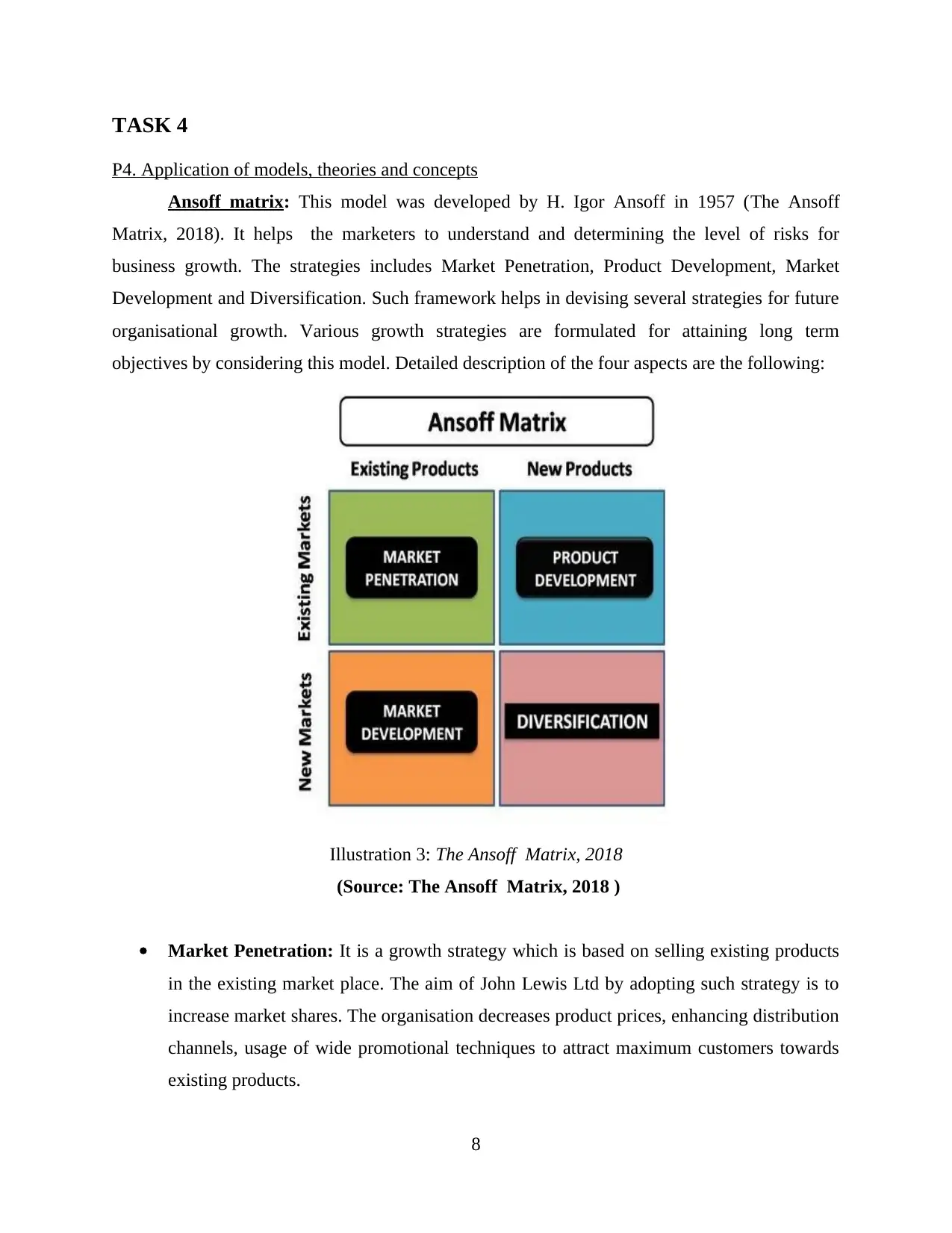
TASK 4
P4. Application of models, theories and concepts
Ansoff matrix: This model was developed by H. Igor Ansoff in 1957 (The Ansoff
Matrix, 2018). It helps the marketers to understand and determining the level of risks for
business growth. The strategies includes Market Penetration, Product Development, Market
Development and Diversification. Such framework helps in devising several strategies for future
organisational growth. Various growth strategies are formulated for attaining long term
objectives by considering this model. Detailed description of the four aspects are the following:
Illustration 3: The Ansoff Matrix, 2018
(Source: The Ansoff Matrix, 2018 )
Market Penetration: It is a growth strategy which is based on selling existing products
in the existing market place. The aim of John Lewis Ltd by adopting such strategy is to
increase market shares. The organisation decreases product prices, enhancing distribution
channels, usage of wide promotional techniques to attract maximum customers towards
existing products.
8
P4. Application of models, theories and concepts
Ansoff matrix: This model was developed by H. Igor Ansoff in 1957 (The Ansoff
Matrix, 2018). It helps the marketers to understand and determining the level of risks for
business growth. The strategies includes Market Penetration, Product Development, Market
Development and Diversification. Such framework helps in devising several strategies for future
organisational growth. Various growth strategies are formulated for attaining long term
objectives by considering this model. Detailed description of the four aspects are the following:
Illustration 3: The Ansoff Matrix, 2018
(Source: The Ansoff Matrix, 2018 )
Market Penetration: It is a growth strategy which is based on selling existing products
in the existing market place. The aim of John Lewis Ltd by adopting such strategy is to
increase market shares. The organisation decreases product prices, enhancing distribution
channels, usage of wide promotional techniques to attract maximum customers towards
existing products.
8
Paraphrase This Document
Need a fresh take? Get an instant paraphrase of this document with our AI Paraphraser
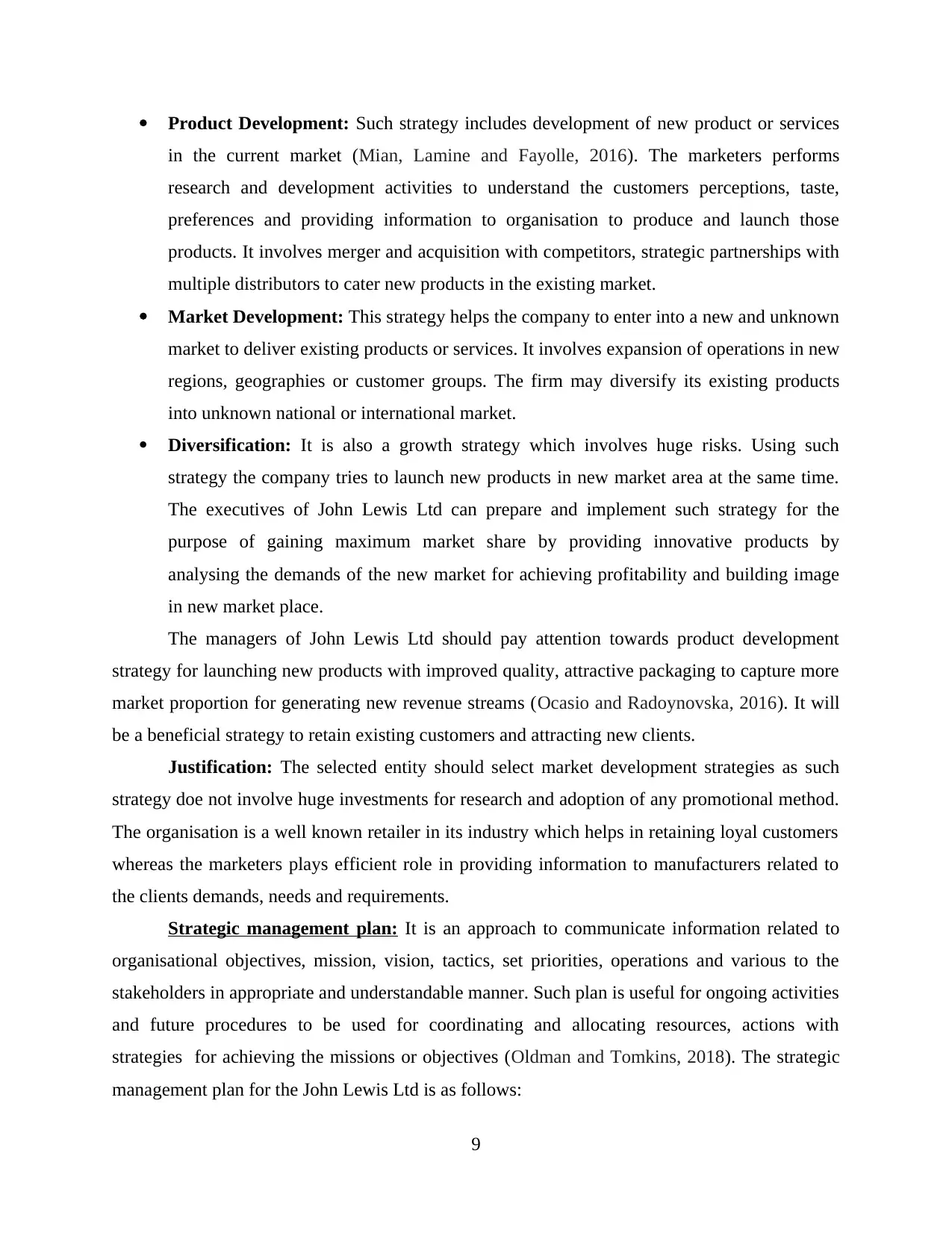
Product Development: Such strategy includes development of new product or services
in the current market (Mian, Lamine and Fayolle, 2016). The marketers performs
research and development activities to understand the customers perceptions, taste,
preferences and providing information to organisation to produce and launch those
products. It involves merger and acquisition with competitors, strategic partnerships with
multiple distributors to cater new products in the existing market.
Market Development: This strategy helps the company to enter into a new and unknown
market to deliver existing products or services. It involves expansion of operations in new
regions, geographies or customer groups. The firm may diversify its existing products
into unknown national or international market.
Diversification: It is also a growth strategy which involves huge risks. Using such
strategy the company tries to launch new products in new market area at the same time.
The executives of John Lewis Ltd can prepare and implement such strategy for the
purpose of gaining maximum market share by providing innovative products by
analysing the demands of the new market for achieving profitability and building image
in new market place.
The managers of John Lewis Ltd should pay attention towards product development
strategy for launching new products with improved quality, attractive packaging to capture more
market proportion for generating new revenue streams (Ocasio and Radoynovska, 2016). It will
be a beneficial strategy to retain existing customers and attracting new clients.
Justification: The selected entity should select market development strategies as such
strategy doe not involve huge investments for research and adoption of any promotional method.
The organisation is a well known retailer in its industry which helps in retaining loyal customers
whereas the marketers plays efficient role in providing information to manufacturers related to
the clients demands, needs and requirements.
Strategic management plan: It is an approach to communicate information related to
organisational objectives, mission, vision, tactics, set priorities, operations and various to the
stakeholders in appropriate and understandable manner. Such plan is useful for ongoing activities
and future procedures to be used for coordinating and allocating resources, actions with
strategies for achieving the missions or objectives (Oldman and Tomkins, 2018). The strategic
management plan for the John Lewis Ltd is as follows:
9
in the current market (Mian, Lamine and Fayolle, 2016). The marketers performs
research and development activities to understand the customers perceptions, taste,
preferences and providing information to organisation to produce and launch those
products. It involves merger and acquisition with competitors, strategic partnerships with
multiple distributors to cater new products in the existing market.
Market Development: This strategy helps the company to enter into a new and unknown
market to deliver existing products or services. It involves expansion of operations in new
regions, geographies or customer groups. The firm may diversify its existing products
into unknown national or international market.
Diversification: It is also a growth strategy which involves huge risks. Using such
strategy the company tries to launch new products in new market area at the same time.
The executives of John Lewis Ltd can prepare and implement such strategy for the
purpose of gaining maximum market share by providing innovative products by
analysing the demands of the new market for achieving profitability and building image
in new market place.
The managers of John Lewis Ltd should pay attention towards product development
strategy for launching new products with improved quality, attractive packaging to capture more
market proportion for generating new revenue streams (Ocasio and Radoynovska, 2016). It will
be a beneficial strategy to retain existing customers and attracting new clients.
Justification: The selected entity should select market development strategies as such
strategy doe not involve huge investments for research and adoption of any promotional method.
The organisation is a well known retailer in its industry which helps in retaining loyal customers
whereas the marketers plays efficient role in providing information to manufacturers related to
the clients demands, needs and requirements.
Strategic management plan: It is an approach to communicate information related to
organisational objectives, mission, vision, tactics, set priorities, operations and various to the
stakeholders in appropriate and understandable manner. Such plan is useful for ongoing activities
and future procedures to be used for coordinating and allocating resources, actions with
strategies for achieving the missions or objectives (Oldman and Tomkins, 2018). The strategic
management plan for the John Lewis Ltd is as follows:
9
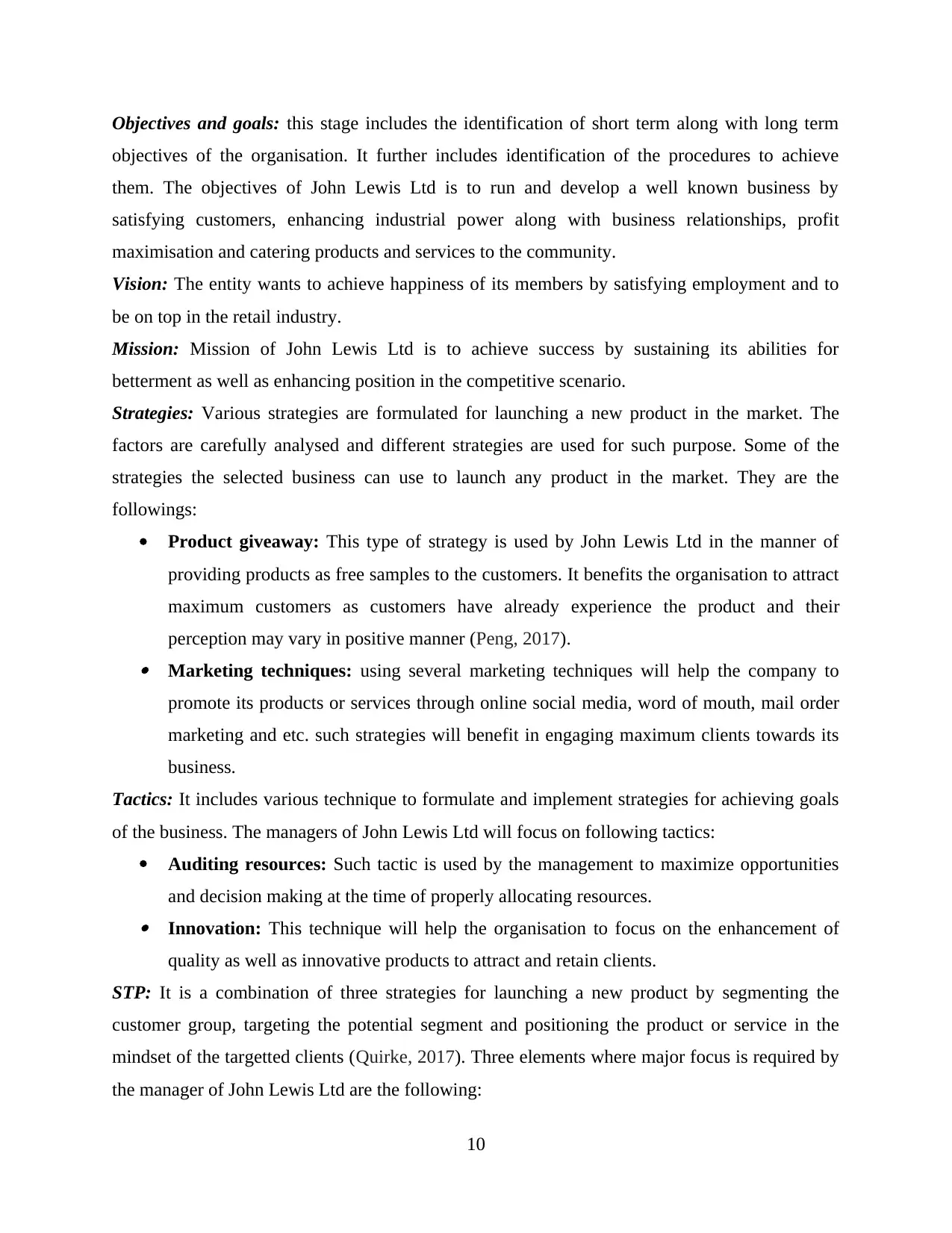
Objectives and goals: this stage includes the identification of short term along with long term
objectives of the organisation. It further includes identification of the procedures to achieve
them. The objectives of John Lewis Ltd is to run and develop a well known business by
satisfying customers, enhancing industrial power along with business relationships, profit
maximisation and catering products and services to the community.
Vision: The entity wants to achieve happiness of its members by satisfying employment and to
be on top in the retail industry.
Mission: Mission of John Lewis Ltd is to achieve success by sustaining its abilities for
betterment as well as enhancing position in the competitive scenario.
Strategies: Various strategies are formulated for launching a new product in the market. The
factors are carefully analysed and different strategies are used for such purpose. Some of the
strategies the selected business can use to launch any product in the market. They are the
followings:
Product giveaway: This type of strategy is used by John Lewis Ltd in the manner of
providing products as free samples to the customers. It benefits the organisation to attract
maximum customers as customers have already experience the product and their
perception may vary in positive manner (Peng, 2017). Marketing techniques: using several marketing techniques will help the company to
promote its products or services through online social media, word of mouth, mail order
marketing and etc. such strategies will benefit in engaging maximum clients towards its
business.
Tactics: It includes various technique to formulate and implement strategies for achieving goals
of the business. The managers of John Lewis Ltd will focus on following tactics:
Auditing resources: Such tactic is used by the management to maximize opportunities
and decision making at the time of properly allocating resources. Innovation: This technique will help the organisation to focus on the enhancement of
quality as well as innovative products to attract and retain clients.
STP: It is a combination of three strategies for launching a new product by segmenting the
customer group, targeting the potential segment and positioning the product or service in the
mindset of the targetted clients (Quirke, 2017). Three elements where major focus is required by
the manager of John Lewis Ltd are the following:
10
objectives of the organisation. It further includes identification of the procedures to achieve
them. The objectives of John Lewis Ltd is to run and develop a well known business by
satisfying customers, enhancing industrial power along with business relationships, profit
maximisation and catering products and services to the community.
Vision: The entity wants to achieve happiness of its members by satisfying employment and to
be on top in the retail industry.
Mission: Mission of John Lewis Ltd is to achieve success by sustaining its abilities for
betterment as well as enhancing position in the competitive scenario.
Strategies: Various strategies are formulated for launching a new product in the market. The
factors are carefully analysed and different strategies are used for such purpose. Some of the
strategies the selected business can use to launch any product in the market. They are the
followings:
Product giveaway: This type of strategy is used by John Lewis Ltd in the manner of
providing products as free samples to the customers. It benefits the organisation to attract
maximum customers as customers have already experience the product and their
perception may vary in positive manner (Peng, 2017). Marketing techniques: using several marketing techniques will help the company to
promote its products or services through online social media, word of mouth, mail order
marketing and etc. such strategies will benefit in engaging maximum clients towards its
business.
Tactics: It includes various technique to formulate and implement strategies for achieving goals
of the business. The managers of John Lewis Ltd will focus on following tactics:
Auditing resources: Such tactic is used by the management to maximize opportunities
and decision making at the time of properly allocating resources. Innovation: This technique will help the organisation to focus on the enhancement of
quality as well as innovative products to attract and retain clients.
STP: It is a combination of three strategies for launching a new product by segmenting the
customer group, targeting the potential segment and positioning the product or service in the
mindset of the targetted clients (Quirke, 2017). Three elements where major focus is required by
the manager of John Lewis Ltd are the following:
10
⊘ This is a preview!⊘
Do you want full access?
Subscribe today to unlock all pages.

Trusted by 1+ million students worldwide
1 out of 14
Related Documents
Your All-in-One AI-Powered Toolkit for Academic Success.
+13062052269
info@desklib.com
Available 24*7 on WhatsApp / Email
![[object Object]](/_next/static/media/star-bottom.7253800d.svg)
Unlock your academic potential
Copyright © 2020–2025 A2Z Services. All Rights Reserved. Developed and managed by ZUCOL.





